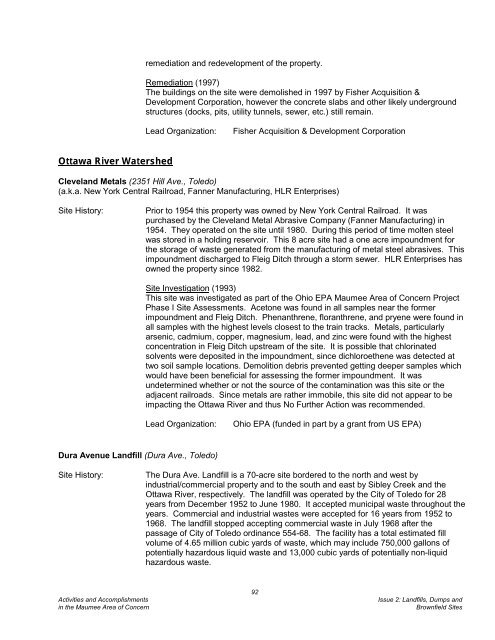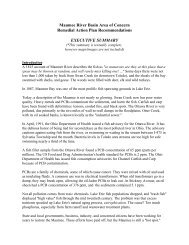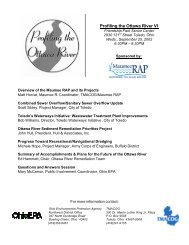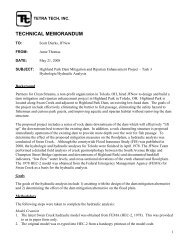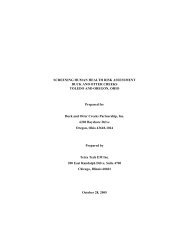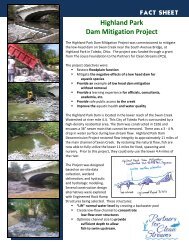Complete report - Partners for Clean Streams
Complete report - Partners for Clean Streams
Complete report - Partners for Clean Streams
Create successful ePaper yourself
Turn your PDF publications into a flip-book with our unique Google optimized e-Paper software.
emediation and redevelopment of the property.<br />
Remediation (1997)<br />
The buildings on the site were demolished in 1997 by Fisher Acquisition &<br />
Development Corporation, however the concrete slabs and other likely underground<br />
structures (docks, pits, utility tunnels, sewer, etc.) still remain.<br />
Lead Organization:<br />
Fisher Acquisition & Development Corporation<br />
Ottawa River Watershed<br />
Cleveland Metals (2351 Hill Ave., Toledo)<br />
(a.k.a. New York Central Railroad, Fanner Manufacturing, HLR Enterprises)<br />
Site History:<br />
Prior to 1954 this property was owned by New York Central Railroad. It was<br />
purchased by the Cleveland Metal Abrasive Company (Fanner Manufacturing) in<br />
1954. They operated on the site until 1980. During this period of time molten steel<br />
was stored in a holding reservoir. This 8 acre site had a one acre impoundment <strong>for</strong><br />
the storage of waste generated from the manufacturing of metal steel abrasives. This<br />
impoundment discharged to Fleig Ditch through a storm sewer. HLR Enterprises has<br />
owned the property since 1982.<br />
Site Investigation (1993)<br />
This site was investigated as part of the Ohio EPA Maumee Area of Concern Project<br />
Phase I Site Assessments. Acetone was found in all samples near the <strong>for</strong>mer<br />
impoundment and Fleig Ditch. Phenanthrene, floranthrene, and pryene were found in<br />
all samples with the highest levels closest to the train tracks. Metals, particularly<br />
arsenic, cadmium, copper, magnesium, lead, and zinc were found with the highest<br />
concentration in Fleig Ditch upstream of the site. It is possible that chlorinated<br />
solvents were deposited in the impoundment, since dichloroethene was detected at<br />
two soil sample locations. Demolition debris prevented getting deeper samples which<br />
would have been beneficial <strong>for</strong> assessing the <strong>for</strong>mer impoundment. It was<br />
undetermined whether or not the source of the contamination was this site or the<br />
adjacent railroads. Since metals are rather immobile, this site did not appear to be<br />
impacting the Ottawa River and thus No Further Action was recommended.<br />
Lead Organization:<br />
Ohio EPA (funded in part by a grant from US EPA)<br />
Dura Avenue Landfill (Dura Ave., Toledo)<br />
Site History:<br />
The Dura Ave. Landfill is a 70-acre site bordered to the north and west by<br />
industrial/commercial property and to the south and east by Sibley Creek and the<br />
Ottawa River, respectively. The landfill was operated by the City of Toledo <strong>for</strong> 28<br />
years from December 1952 to June 1980. It accepted municipal waste throughout the<br />
years. Commercial and industrial wastes were accepted <strong>for</strong> 16 years from 1952 to<br />
1968. The landfill stopped accepting commercial waste in July 1968 after the<br />
passage of City of Toledo ordinance 554-68. The facility has a total estimated fill<br />
volume of 4.65 million cubic yards of waste, which may include 750,000 gallons of<br />
potentially hazardous liquid waste and 13,000 cubic yards of potentially non-liquid<br />
hazardous waste.<br />
92<br />
Activities and Accomplishments<br />
Issue 2: Landfills, Dumps and<br />
in the Maumee Area of Concern Brownfield Sites


